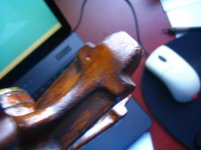Romak
Aluminum
- Joined
- Nov 2, 2011
- Location
- Surrey, BC
Dear engineers.
I have another interesting find. It looks like a foundry pattern or a mold of an unknown antique machinery part. I think it might be a final cast iron sprocket or a toothed wheel engaged with a chain in some kind of old machinery. The pattern have teeth that might be made for a chain. If you have any thoughts, please let me know since I have never seen a similar sprocket on any old machinery.
Thank you!!!





I have another interesting find. It looks like a foundry pattern or a mold of an unknown antique machinery part. I think it might be a final cast iron sprocket or a toothed wheel engaged with a chain in some kind of old machinery. The pattern have teeth that might be made for a chain. If you have any thoughts, please let me know since I have never seen a similar sprocket on any old machinery.
Thank you!!!






